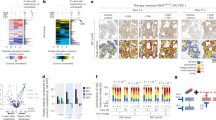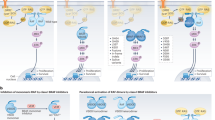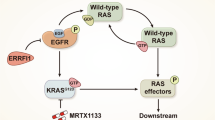Abstract
Inhibition of the BRAF(V600E) oncoprotein by the small-molecule drug PLX4032 (vemurafenib) is highly effective in the treatment of melanoma1. However, colon cancer patients harbouring the same BRAF(V600E) oncogenic lesion have poor prognosis and show only a very limited response to this drug2,3,4. To investigate the cause of the limited therapeutic effect of PLX4032 in BRAF(V600E) mutant colon tumours, here we performed an RNA-interference-based genetic screen in human cells to search for kinases whose knockdown synergizes with BRAF(V600E) inhibition. We report that blockade of the epidermal growth factor receptor (EGFR) shows strong synergy with BRAF(V600E) inhibition. We find in multiple BRAF(V600E) mutant colon cancers that inhibition of EGFR by the antibody drug cetuximab or the small-molecule drugs gefitinib or erlotinib is strongly synergistic with BRAF(V600E) inhibition, both in vitro and in vivo. Mechanistically, we find that BRAF(V600E) inhibition causes a rapid feedback activation of EGFR, which supports continued proliferation in the presence of BRAF(V600E) inhibition. Melanoma cells express low levels of EGFR and are therefore not subject to this feedback activation. Consistent with this, we find that ectopic expression of EGFR in melanoma cells is sufficient to cause resistance to PLX4032. Our data suggest that BRAF(V600E) mutant colon cancers (approximately 8–10% of all colon cancers2,3,5), for which there are currently no targeted treatment options available, might benefit from combination therapy consisting of BRAF and EGFR inhibitors.
This is a preview of subscription content, access via your institution
Access options
Subscribe to this journal
Receive 51 print issues and online access
$199.00 per year
only $3.90 per issue
Buy this article
- Purchase on SpringerLink
- Instant access to full article PDF
Prices may be subject to local taxes which are calculated during checkout




Similar content being viewed by others
References
Chapman, P. B. et al. Improved survival with vemurafenib in melanoma with BRAF V600E mutation. N. Engl. J. Med. 364, 2507–2516 (2011)
Roth, A. D. et al. Prognostic role of KRAS and BRAF in stage II and III resected colon cancer: results of the translational study on the PETACC-3, EORTC 40993, SAKK 60-00 trial. J. Clin. Oncol. 28, 466–474 (2010)
Richman, S. D. et al. KRAS and BRAF mutations in advanced colorectal cancer are associated with poor prognosis but do not preclude benefit from oxaliplatin or irinotecan: results from the MRC FOCUS trial. J. Clin. Oncol. 27, 5931–5937 (2009)
Kopetz, S. et al. PLX4032 in metastatic colon cancer patients with mutant BRAF tumors. J. Clin. Oncol. 28 abstract 3534 (2010)
Tol, J., Nagtegaal, I. D. & Punt, C. J. BRAF mutation in metastatic colorectal cancer. N. Engl. J. Med. 361, 98–99 (2009)
Davies, H. et al. Mutations of the BRAF gene in human cancer. Nature 417, 949–954 (2002)
Di Nicolantonio, F. et al. Wild-type BRAF is required for response to panitumumab or cetuximab in metastatic colorectal cancer. J. Clin. Oncol. 26, 5705–5712 (2008)
Nikiforova, M. N. et al. BRAF mutations in thyroid tumors are restricted to papillary carcinomas and anaplastic or poorly differentiated carcinomas arising from papillary carcinomas. J. Clin. Endocrinol. Metab. 88, 5399–5404 (2003)
Kimura, E. T. et al. High prevalence of BRAF mutations in thyroid cancer: genetic evidence for constitutive activation of the RET/PTC-RAS-BRAF signaling pathway in papillary thyroid carcinoma. Cancer Res. 63, 1454–1457 (2003)
Trovisco, V. et al. BRAF mutations are associated with some histological types of papillary thyroid carcinoma. J. Pathol. 202, 247–251 (2004)
Kaelin, W. G., Jr The concept of synthetic lethality in the context of anticancer therapy. Natl. Rev. 5, 689–698 (2005)
Manning, G., Whyte, D. B., Martinez, R., Hunter, T. & Sudarsanam, S. The protein kinase complement of the human genome. Science 298, 1912–1934 (2002)
Karapetis, C. S. et al. K-ras mutations and benefit from cetuximab in advanced colorectal cancer. N. Engl. J. Med. 359, 1757–1765 (2008)
Amado, R. G. et al. Wild-type KRAS is required for panitumumab efficacy in patients with metastatic colorectal cancer. J. Clin. Oncol. 26, 1626–1634 (2008)
Wang, R. et al. Regulation of Cdc25C by ERK-MAP kinases during the G2/M transition. Cell 128, 1119–1132 (2007)
Wang, Z., Wang, M., Lazo, J. S. & Carr, B. I. Identification of epidermal growth factor receptor as a target of Cdc25A protein phosphatase. J. Biol. Chem. 277, 19470–19475 (2002)
Salomon, D. S., Brandt, R., Ciardiello, F. & Normanno, N. Epidermal growth factor-related peptides and their receptors in human malignancies. Crit. Rev. Oncol. Hematol. 19, 183–232 (1995)
Simbulan-Rosenthal, C. M., Rosenthal, D. S., Iyer, S., Boulares, A. H. & Smulson, M. E. Transient poly(ADP-ribosyl)ation of nuclear proteins and role of poly(ADP-ribose) polymerase in the early stages of apoptosis. J. Biol. Chem. 273, 13703–13712 (1998)
Tiacci, E. et al. BRAF mutations in hairy-cell leukemia. N. Engl. J. Med. 364, 2305–2315 (2011)
Boone, B. et al. EGFR in melanoma: clinical significance and potential therapeutic target. J. Cutan. Pathol. 38, 492–502 (2011)
Brummelkamp, T. R. et al. An shRNA barcode screen provides insight into cancer cell vulnerability to MDM2 inhibitors. Nature Chem. Biol. 2, 202–206 (2006)
Huang, S. et al. ZNF423 is critically required for retinoic acid-induced differentiation and is a marker of neuroblastoma outcome. Cancer Cell 15, 328–340 (2009)
Acknowledgements
We thank P. Kumar, V. Gambino and W. Grernrum for assistance with experiments. We are grateful to C. Pochet for support. Major financial support for this work was provided by the EU Seventh Framework Programme, grant agreement 259015 (to A.B. and R.B.). Additional funding was provided by a European Research Council grant to R.B.; The Cancer Systems Biology Center grant by the Netherlands Organisation for Scientific Research (NWO); The Dutch Cancer Society; The Netherlands Genomics Initiative (NGI); The Associazione Italiana per la Ricerca sul Cancro (AIRC), 2010 Special Program Molecular Clinical Oncology 5x1000, project 9970; AIRC Investigator Grant (to A.B.); Italian Ministry of University and Research; Italian Ministry of Health, Regione Piemonte (to A.B. and F.D.N.); and Intramural Grant, 5xmille 2008; and Fondazione Piemontese per la Ricerca sul Cancro (to A.B. and F.D.N.).
Author information
Authors and Affiliations
Contributions
R.B. and A.B. conceived the project and supervised all research. R.B., A.P. and S.H. wrote the manuscript. S.H., R.S. and RL.B. designed the experiments. A.P., C.S., S.H., F.D.N. and D.Z. performed the experiments.
Corresponding author
Ethics declarations
Competing interests
The authors declare no competing financial interests.
Supplementary information
Supplementary Figures
The file contains Supplementary Figures 1-6 with legends. (PDF 2490 kb)
Supplementary Table 1
This file shows kinases screened for enhancers of PLX4032 sensitivity. Listed are the gene symbols for the genes tested in the PLX4032 sensitivity screen and the number of shRNAs for each gene present in the library. (XLS 349 kb)
Supplementary Table 2
This file shows the top shRNA candidates from the 'dropout' RNAi screen for enhancers of PLX4032 sensitivity. Listed are the 22 top shRNA candidates that had been sequenced at least 300 times and which were depleted at least five-fold by the drug treatment. (XLS 37 kb)
Rights and permissions
About this article
Cite this article
Prahallad, A., Sun, C., Huang, S. et al. Unresponsiveness of colon cancer to BRAF(V600E) inhibition through feedback activation of EGFR. Nature 483, 100–103 (2012). https://doi.org/10.1038/nature10868
Received:
Accepted:
Published:
Issue Date:
DOI: https://doi.org/10.1038/nature10868



